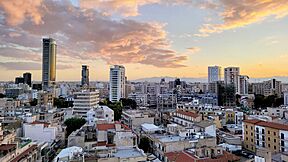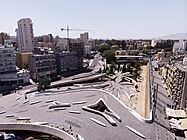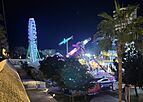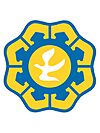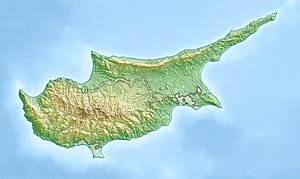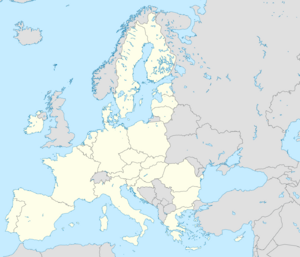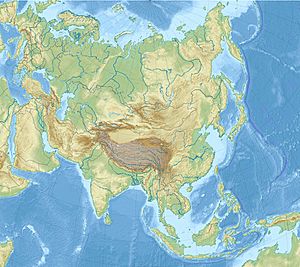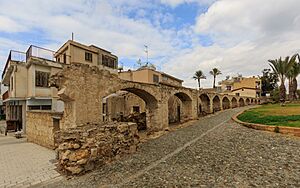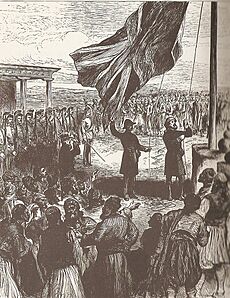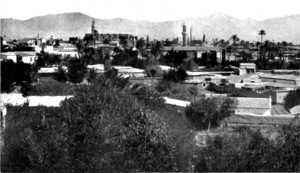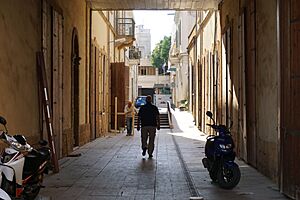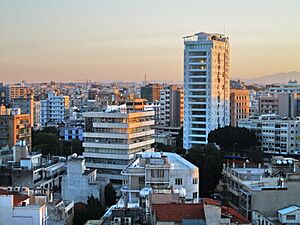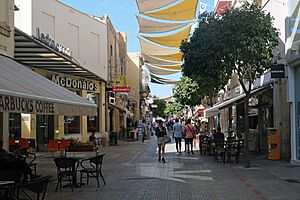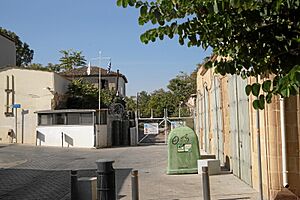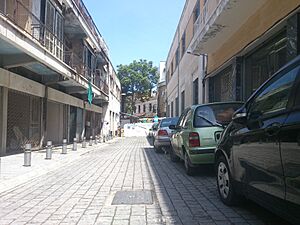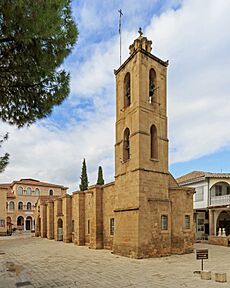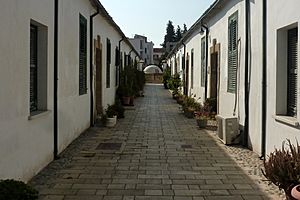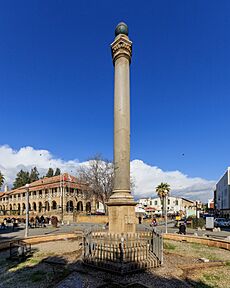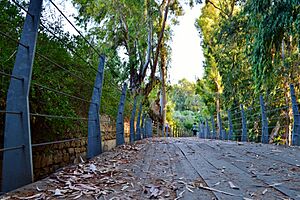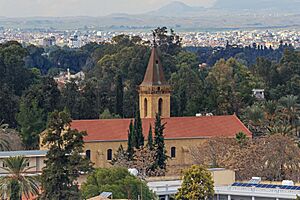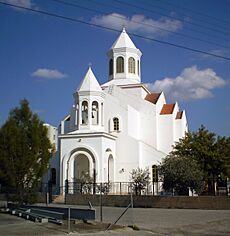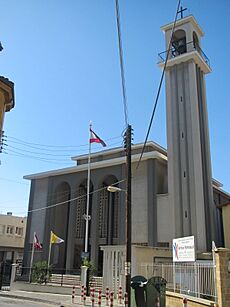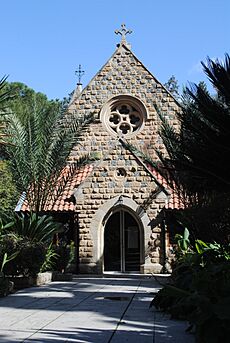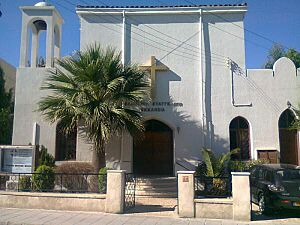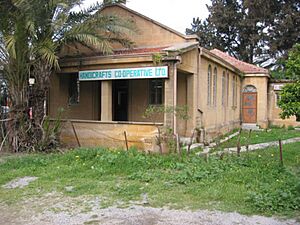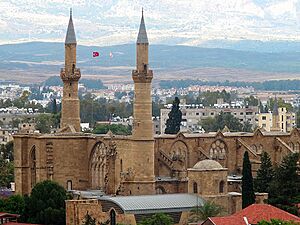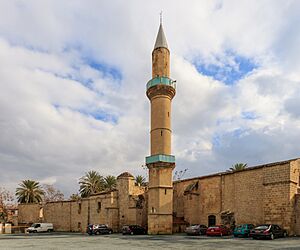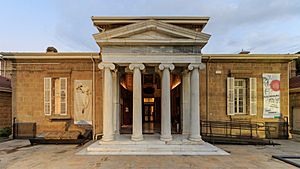Nicosia facts for kids
Quick facts for kids
Nicosia
|
|||
|---|---|---|---|
|
Capital city and municipality
|
|||
|
Left to right: Nicosia skyline from Shacolas Tower; Ledra Street from Socratous Street; Eleftheria Square; door in the Old Town; Venetian Homes; Nicosia Christmas fair at Eleftheria Square; Makariou Avenue
|
|||
|
|||
| Claimed by | |||
| Country (de jure) | |||
| • District | Nicosia District | ||
| Country (northern part, de facto) | |||
| • District | Lefkoşa District | ||
| Area | |||
| • Land | 51.06 km2 (19.71 sq mi) | ||
| Elevation | 220 m (720 ft) | ||
| Population
(2016)
|
|||
| • Municipality |
|
||
| • Urban |
|
||
| Demonym(s) | Nicosian | ||
| Time zone | UTC+2 (EET) | ||
| • Summer (DST) | UTC+3 (EEST) | ||
| Post code |
1010–1107
|
||
| Area code | 22 | ||
| ISO 3166 code | CY-01 | ||
| Website |
|
||
Nicosia (also called Lefkosia in Greek and Lefkoşa in Turkish) is the capital and largest city of Cyprus. It is the capital city furthest to the southeast in all European Union countries.
Nicosia has been lived in for over 4,500 years. It has been the capital of Cyprus since the 10th century. It is the last capital city in Europe that is still divided. After Cyprus became independent from British rule in 1960, fighting broke out between Greek Cypriots and Turkish Cypriots in 1963. This led to the city's Greek and Turkish communities separating into its south and north parts in 1964.
Later, in 1974, Turkey invaded Cyprus after a coup attempt to unite the island with Greece. A dividing line, called the Green Line, now runs through Nicosia. This line is controlled by the United Nations and separates the internationally recognized Republic of Cyprus from Northern Cyprus, which is only recognized by Turkey. This ongoing disagreement is known as the Cyprus problem.
Besides being the center for laws and government, Nicosia is also the island's main financial hub. It is a major place for international business. In 2018, Nicosia was ranked as the 32nd richest city in the world based on how much people could buy there.
Contents
- Understanding Nicosia's Names
- A Brief History of Nicosia
- Nicosia's Climate and Weather
- Exploring Nicosia's Cityscape
- Religious Buildings in Nicosia
- Nicosia's Culture and Arts
- Education in Nicosia
- Nicosia's Economy and Business
- Getting Around Nicosia: Transport
- Sports in Nicosia
- Famous People from Nicosia
- Nicosia's Sister Cities
- Images for kids
- See also
Understanding Nicosia's Names
The city's earliest known name was Lidir, mentioned in an Assyrian text from 672 BC. Over time, this name changed in Greek to forms like Ledra.
Later, in early Christian times, the city was called names like Leuteon or Leucon. These names included Greek words for "white" or "poplar tree."
During the Byzantine period, the name Leucosia became common. This likely meant "the white estate." This name then developed into the modern Greek Lefkosia and Turkish Lefkoşa.
The name Nicosia, used in Latin and English, appeared during the medieval Crusader rule by the House of Lusignan.
A Brief History of Nicosia
Nicosia has a very long history, with people living there continuously since about 2500 BC. This was at the beginning of the Bronze Age.
Ancient Beginnings of Nicosia
The ancient city-state of Ledra was located near modern Nicosia. It was one of the twelve ancient kingdoms of Cyprus. Around 330 BC, Ledra was a small farming town, not as big as the coastal cities that focused on trade.
In the 4th century, it became an important religious center with a bishop. Old buildings show that it was a wealthy Christian community during this time.
Medieval Nicosia's Rise
After the capital city of Salamis was destroyed by Arab raids in 647 AD, inland towns became more important. Nicosia grew because it was safe from coastal attacks and had a good water supply.
Around 965 AD, the Byzantine Empire made Nicosia the capital of Cyprus. This was mainly for safety. The Byzantines built a small fort in the city. The economy focused on farming goods and luxury items.
In 1191, Richard I of England (Richard the Lionheart) invaded Cyprus during the Third Crusade. He defeated the island's ruler and then sold Cyprus to the Knights Templar.
The Frankish rule began in 1192 and lasted until 1489. Nicosia became the capital of the medieval Kingdom of Cyprus. During this time, city walls were built, along with palaces and the St. Sophia Cathedral.
In 1489, Cyprus came under the rule of the Republic of Venice. The Venetians saw the need to fortify all Cypriot cities because of the threat from the Ottoman Empire. In 1567, they built new, stronger walls around Nicosia. These walls were shaped like a star with eleven bastions, which are still well-preserved today. The walls had three gates: Kyrenia Gate, Famagusta Gate, and Paphos Gate. The Pedieos river, which used to flow through the city, was moved outside the walls for defense.
Ottoman Rule in Nicosia
On September 9, 1570, the Ottomans captured Nicosia after a 40-day siege. About 20,000 residents died, and many buildings were looted. The city's population dropped sharply. Many Christian churches were turned into mosques, including the Saint Sophia Cathedral.
Nicosia became the center of Ottoman rule in Cyprus. The Venetian government palace became the seat of the Pasha, the Ottoman governor. The city was divided into 12 quarters, many named after Ottoman generals. Later, the number of neighborhoods grew to 24. Each neighborhood was centered around a mosque or a church, where Muslim and Christian communities lived.
British Influence and Independence
Nicosia came under the rule of the United Kingdom on July 5, 1878. The British built new government buildings and established a Municipal Council in 1882 to manage the city.
The city's boundaries expanded over the years. Nicosia International Airport opened in 1947.
In 1955, a fight against British rule began, led by the EOKA group. Their goal was to unite Cyprus with Greece. However, Cyprus gained independence in 1960 instead. During this time, Nicosia saw many protests against British rule.
Nicosia's Division and Modern Challenges
In 1960, Nicosia became the capital of the Republic of Cyprus. In 1963, fighting broke out between Greek and Turkish Cypriots. Nicosia was divided by the Green Line, which separated the Greek and Turkish Cypriot areas. Many Turkish Cypriots moved to the northern part of Nicosia, causing overcrowding.
On July 15, 1974, there was a coup attempt to unite the island with Greece. This led to the Turkish invasion of Cyprus on July 20, 1974. Turkish forces captured the northern part of Nicosia and about 37% of Cypriot land. This conflict created a large refugee problem for both sides.
In 1975, the Turkish Cypriot community declared the Turkish Federated State of Cyprus. In 1983, they declared independence as the Turkish Republic of Northern Cyprus. Only Turkey recognizes this state; the rest of the world sees it as part of the Republic of Cyprus.
On April 23, 2003, the Ledra Palace crossing point opened through the Green Line. This was the first time people could cross since 1974. Other crossing points, like Ledra Street, also reopened later.
For a short time, Nicosia was the only capital city in the world with two time zones. This happened when Northern Cyprus decided to stay on UTC+03:00 year-round in 2016. However, they returned to standard time the following year.
Nicosia's Climate and Weather
Nicosia has a hot semi-arid climate. This means it has long, very hot, and dry summers. Winters are mild, and most rain falls during this season. Snow is very rare in Nicosia. The highest temperature ever recorded in Cyprus was in Nicosia, reaching 46.2°C (115.2°F) on September 4, 2020.
| Climate data for Athalassa, Nicosia, elevation: 162 m (1991–2020) (Satellite view) | |||||||||||||
|---|---|---|---|---|---|---|---|---|---|---|---|---|---|
| Month | Jan | Feb | Mar | Apr | May | Jun | Jul | Aug | Sep | Oct | Nov | Dec | Year |
| Record high °C (°F) | 24.0 (75.2) |
27.8 (82.0) |
33.4 (92.1) |
39.0 (102.2) |
43.9 (111.0) |
44.6 (112.3) |
44.6 (112.3) |
45.6 (114.1) |
45.3 (113.5) |
40.4 (104.7) |
32.6 (90.7) |
28.4 (83.1) |
45.6 (114.1) |
| Mean daily maximum °C (°F) | 15.8 (60.4) |
16.6 (61.9) |
20.0 (68.0) |
24.7 (76.5) |
29.8 (85.6) |
34.4 (93.9) |
37.5 (99.5) |
37.4 (99.3) |
34.0 (93.2) |
29.2 (84.6) |
22.7 (72.9) |
17.7 (63.9) |
26.7 (80.1) |
| Daily mean °C (°F) | 10.7 (51.3) |
11.2 (52.2) |
13.8 (56.8) |
17.7 (63.9) |
22.6 (72.7) |
27.1 (80.8) |
30.0 (86.0) |
30.0 (86.0) |
26.7 (80.1) |
22.5 (72.5) |
16.8 (62.2) |
12.5 (54.5) |
20.1 (68.2) |
| Mean daily minimum °C (°F) | 5.7 (42.3) |
5.8 (42.4) |
7.6 (45.7) |
10.8 (51.4) |
15.3 (59.5) |
19.8 (67.6) |
22.6 (72.7) |
22.5 (72.5) |
19.4 (66.9) |
15.9 (60.6) |
10.8 (51.4) |
7.3 (45.1) |
13.6 (56.5) |
| Record low °C (°F) | −2.3 (27.9) |
−2.9 (26.8) |
0.0 (32.0) |
1.6 (34.9) |
7.5 (45.5) |
10.6 (51.1) |
10.5 (50.9) |
16.3 (61.3) |
13.0 (55.4) |
5.4 (41.7) |
0.3 (32.5) |
−1.5 (29.3) |
−2.9 (26.8) |
| Average precipitation mm (inches) | 53.2 (2.09) |
41.5 (1.63) |
29.1 (1.15) |
21.1 (0.83) |
26.2 (1.03) |
14.5 (0.57) |
4.9 (0.19) |
1.2 (0.05) |
10.8 (0.43) |
24.4 (0.96) |
39.3 (1.55) |
64.1 (2.52) |
330.2 (13.00) |
| Average precipitation days (≥ 1.0 mm) | 24.3 | 21.9 | 15.9 | 11.3 | 9.4 | 3.7 | 1.5 | 1.0 | 2.8 | 10.0 | 13.0 | 24.6 | 139.4 |
| Average relative humidity (%) | 76 | 74 | 68 | 62 | 58 | 53 | 53 | 58 | 59 | 62 | 69 | 77 | 64 |
| Mean monthly sunshine hours | 180.0 | 190.5 | 240.5 | 271.8 | 327.7 | 368.3 | 385.9 | 364.4 | 306.8 | 269.2 | 216.2 | 176.9 | 3,298.4 |
| Source: World Meteorological Organization Normals (NOAA) | |||||||||||||
Exploring Nicosia's Cityscape
Nicosia has the least green spaces of any capital city in Europe. Only three percent of the city is covered with trees.
South of the Green Line: Key Landmarks
Ledra Street is in the center of the old walled city. It has always been the busiest shopping street. Nearby streets lead to lively areas with shops, bars, and cafes. The street is about 1 kilometer long and connects the south and north parts of the old city. During the EOKA struggle (1955-1959), it was nicknamed The Murder Mile because of frequent attacks on British colonialists.
In 1963, fighting between Greek and Turkish Cypriots led to Ledra Street being blocked. After the 1974 Turkish invasion, a buffer zone was created, running through Ledra Street. After many years, Ledra Street was reopened on April 3, 2008.
East of Ledra Street is Faneromeni Square, which was the city's main center before 1974. It has historic buildings like Faneromeni Church (built in 1872), Faneromeni School, and Faneromeni Library. The church holds the tombs of an archbishop and bishops executed by the Ottomans in 1821.
The Archbishop's Palace is at Archbishop Kyprianos Square. It looks old but was built in 1956 in a Venetian style. Next to it is the Gothic St. John's Cathedral (1665) with beautiful frescos.
The old city walls have three gates: Kyrenia Gate (north), Famagusta Gate (east), and Paphos Gate (west). All three are well-preserved. Famagusta Gate is now used for art shows and concerts. While the historic center is inside the walls, the modern city has grown far beyond them.
The main square today is Eleftheria (Freedom) Square. It has the city hall, post office, and library. This square, redesigned by Zaha Hadid Architects, connects the old city with the new. In the new city, you'll find main shopping streets like Stasikratous Street and Makariou Avenue.
Nicosia is also known for its museums. The Archbishop's Palace has a Byzantine museum with the largest collection of religious icons on the island. The Leventis Municipal Museum shows the history of Nicosia from ancient times to today. Other museums include the Folk Art Museum and the Cyprus Ethnological Museum.
Nicosia also has an Armenian archbishopric, a small Buddhist temple, a Maronite archbishopric, and a Roman Catholic church.
North of the Green Line: Key Landmarks
At the center of the walled city in the north is Sarayönü Square. It's called "the heart of Nicosia" for the Turkish Cypriot community. In the middle stands the Venetian Column, a symbol of the government. The Girne Avenue connects this square to the Kyrenia Gate. This avenue is known for its many shops and restaurants.
Near the Ledra Street checkpoint is the Arasta area. This area became pedestrian-only in 2013 and has historic shopping streets with traditional items. Nearby, Büyük Han, built in 1572 by the Ottomans, is the largest caravanserai (a roadside inn for travelers) on the island. It now serves as a cultural center.
To the west of Girne Avenue is the Samanbahçe neighborhood. Built in the 19th century, it's considered the first example of social housing in Cyprus. It's still a residential area and shows Cypriot culture well.
Another central point is the Selimiye Mosque, which was originally the St. Sophia Cathedral. Built between 1209 and 1228, it's the main religious center in Northern Cyprus. Next to it is the Bedesten, a large Greek church from the 14th century, now used as a cultural center for concerts and festivals.
The areas outside the walled city in the north are more open, with wider roads. These areas have many multi-story concrete buildings. The Dereboyu Avenue is the modern entertainment center of the northern part of Nicosia.
Religious Buildings in Nicosia
Nicosia has a mix of different religious buildings, including Greek Orthodox churches, Armenian Apostolic churches, Latin Catholic, Maronite Catholic, Anglican churches, Evangelical churches, mosques, and synagogues.
Armenian Apostolic Church
One of the oldest Armenian churches, the Benedictine Abbey of Our Lady of Tyre, was founded in the 13th century. It became an Armenian church before 1504. Since 1963, this church has been in North Nicosia. It was restored between 2007 and 2013 and won an award for its renovation.
A new Armenian church, "Sourp Asdvadzadzin," was built in Strovolos in the south. Its foundation stone was laid in 1976, and it opened in 1981.
Maronite Catholic Church
The Maronite community is a traditional group in Nicosia. The main church for Maronites is the Our Lady of Grace Cathedral.
The first cathedral was dedicated to St. John but was turned into a mosque during Ottoman rule. The current Our Lady of Grace church is near the Franciscan church. In 2010, Pope Benedict XVI visited this cathedral.
Anglican Church
The Church of St. Paul was built in 1893 when Cyprus was under British rule. Its design looks like an English parish church. Today, it is part of the Diocese of Cyprus and the Gulf.
Greek Evangelical Church
The Greek Evangelical Church of Nicosia is a modern building for the local Protestant community. It also serves Protestants of other nationalities, like Armenian, American, and Korean. It is on Gladstone Street.
Armenian Evangelical Church
Armenian Evangelicals came to Cyprus after the British arrived in 1878. They built a small church on Mahmoud Pasha Street in the northern part of Nicosia. This church was dedicated on July 1, 1947.
Converted Cathedral: Selimiye Mosque
The Cathedral of Saint Sophia, built in 1326 as a Catholic church, is now the Selimiye Mosque in North Nicosia. It is the largest and oldest surviving Gothic church in Cyprus.
During the 1570 Ottoman siege, the cathedral offered shelter. When the city fell, Ottoman soldiers stormed the building, removed Christian items, and converted it into a mosque. This was done as a symbol of conquest. The first Friday prayer was held on September 15, 1570. Two minarets were added later.
The mosque became the property of the Sultan Selim Foundation, which maintained it. It was the largest mosque on the island and used weekly by Ottoman officials for Friday prayers.
Islam in Nicosia
Nicosia has over 15 mosques, some built as mosques and others converted from churches. The Ömeriye Mosque, in the southern part of Nicosia, was originally the Augustinian Church of Saint Mary from the 14th century.
The church was damaged during the 1570 siege and later leveled. After the Ottoman conquest, a mosque was built on the site. This was based on a belief that Umar, the second caliph of Islam, was buried there in the 7th century.
According to Turkish Cypriot stories, the Ömeriye Mosque was the first mosque where Turks prayed after the 1571 conquest. Today, the mosque is open for worship and visitors.
Nicosia's Culture and Arts
The Cyprus Museum is the largest and oldest archaeological museum in Cyprus. In old Nicosia, the Ethnological Museum (Hadjigeorgakis Kornesios Mansion) shows how people lived during the late Ottoman rule. This mansion won an award for its renovation and displays artifacts from Byzantine, Medieval, and Ottoman times. Other museums include the Cyprus Museum of Natural History and the Leventis Municipal Museum of Nicosia.
In the north, the Dervish Pasha Mansion is an ethnological museum with Ottoman and archaeological items. Other museums there include the Lusignan House and the Mevlevi Tekke Museum.
Art galleries in Nicosia include the Leventis Gallery, which has over 800 paintings by Cypriot, Greek, and European artists.
Nicosia offers many music and theater events. These are organized by the city or other groups. Places for performances include:
- The Cyprus National Theater, with two spaces:
- The 550-seat Lyric Theater.
- The 150-seat New Theater.
- The Pallas Cinema-Theater.
- Theatro Ena.
- Maskarini Theater.
- Dionysos Theater.
- Melina Mercouri Hall.
- Theatro Dentro.
Nicosia's universities also have many facilities for cultural events. The Near East University has the Atatürk Cultural and Conference Center with 700 seats.
Education in Nicosia
Nicosia has a large student population. It is home to five universities: the University of Cyprus (UCY), the University of Nicosia, the European University Cyprus, the Open University of Cyprus, and Frederick University. The city also has the oldest high school in Cyprus, Pancyprian Gymnasium.
Nicosia was also home to the Melkonian Educational Institute, a historic Armenian school. It was founded in 1926 as an orphanage after the Armenian Genocide and operated until 2005.
Nicosia's Economy and Business
Nicosia is the main financial and business center of Cyprus. It hosts the headquarters of all Cypriot banks, like the Bank of Cyprus and the Hellenic Bank. The Central Bank of Cyprus is also located here.
Many international businesses have their Cypriot headquarters in Nicosia, including large accounting firms like PWC and Deloitte. Technology companies like NCR also have regional offices here. Nicosia is home to financial newspapers such as the Financial Mirror. The largest mall in Cyprus, Nicosia Mall, is in the city.
In 2011, a survey by UBS found Nicosia to be the wealthiest city per person in the Eastern Mediterranean. It was also the tenth richest city in the world based on purchasing power.
Getting Around Nicosia: Transport
Nicosia is connected to other major cities in Cyprus by a modern motorway network. The A1 goes to Limassol, and the A2 goes to Larnaca. The A9 connects Nicosia to western villages and the Troodos mountains.
The capital is also linked to two international airports: Larnaca International Airport and Paphos International Airport. Nicosia International Airport stopped commercial flights in 1974 and is now within the Green Line buffer zone, used by the United Nations Peacekeeping Force in Cyprus. Ercan International Airport is 13 kilometers from Nicosia, but flights there are internationally banned due to the Cyprus problem. Planes flying to Northern Cyprus from other countries must stop in Turkey first.
Public transport within the city is provided by a bus service. Many taxi companies also operate in Nicosia, and fares are regulated by law.
In 2010, a study looked into building a tram network in Nicosia. In 2011, the Nicosia Municipality started a bicycle sharing system called Bike in Action. There is no operating train network in Cyprus today, though there were plans for one in the past.
Sports in Nicosia
Football is the most popular sport in Cyprus. Nicosia is home to three major teams: APOEL, Omonia, and Olympiakos. APOEL and Omonia are very strong in Cypriot football. There are also many other football clubs in Nicosia and its suburbs.
Nicosia also has many clubs for basketball, handball, and other sports. Keravnos is a major basketball team. The Gymnastic Club Pancypria (GSP), which owns the Neo GSP Stadium, is a big athletics club. All teams in the Futsal First Division are from Nicosia.
Nicosia has some of the largest sports venues on the island. The Neo GSP Stadium can hold 23,400 people and is home to the national team, APOEL, Olympiakos, and Omonia. The Makario Stadium has a capacity of 16,000. In the north, the Nicosia Atatürk Stadium can hold 28,000.
The Eleftheria Indoor Hall is the biggest basketball stadium in Cyprus, with 6,500 seats. It is home to the national team, APOEL, and Omonia. The Lefkotheo indoor arena is used for volleyball.
The Nicosia Marathon took place in 2010 and 2012, attracting over 7,000 participants. Nicosia has also hosted international sports events, including shooting, basketball, and the Games of the Small States of Europe in 1989 and 2009.
Famous People from Nicosia
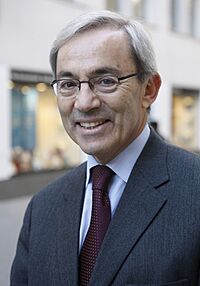
- Peter I of Cyprus (1328–1369), King of Cyprus
- Kıbrıslı Mehmed Kamil Pasha (1833–1913), a very important official in the Ottoman Empire.
- Fazıl Küçük (1906–1984), former Vice President of the Republic of Cyprus.
- Glafkos Klerides (1919–2013), former President of the Republic of Cyprus.
- Tassos Papadopoulos (1934–2008), former President of the Republic of Cyprus.
- Christopher A. Pissarides, a Nobel Prize winner in Economics.
- Mick Karn (1958–2011), a musician.
- Hazar Ergüçlü (born 1992), an actress.
- Vladimiros Tziortzis (born 1997), a racing driver.
Nicosia's Sister Cities
Nicosia is connected with other cities around the world, called "sister cities." These partnerships help promote cultural ties and understanding.
 Athens, Greece (1988)
Athens, Greece (1988) Bucharest, Romania (2004)
Bucharest, Romania (2004) Doha, Qatar
Doha, Qatar İzmir, Turkey
İzmir, Turkey Ankara, Turkey
Ankara, Turkey Odesa, Ukraine (1996)
Odesa, Ukraine (1996) Shiraz, Iran (1999)
Shiraz, Iran (1999)
Friendly Cities
Nicosia also works with these cities:
Images for kids
See also
 In Spanish: Nicosia para niños
In Spanish: Nicosia para niños


